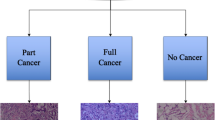Abstract
Cholangiocarcinoma, cancer of the bile ducts, is often diagnosed via magnetic resonance cholangiopancreatography (MRCP). Due to low resolution, noise and difficulty is actually seeing the tumor in the images, especially by examining only a single image, there has been very little development of automated systems for cholangiocarcinoma diagnosis. This paper presents a computer-aided diagnosis (CAD) system for the automated preliminary detection of the tumor using a single MRCP image. The multi-stage system employs algorithms and techniques that correspond to the radiological diagnosis characteristics employed by doctors. A popular artificial neural network, the multi-layer perceptron (MLP), is used for decision making to differentiate images with cholangiocarcinoma from those without. The test results achieved was 94% when differentiating only healthy and tumor images, and 88% in a robust multi-disease test where the system had to identify the tumor images from a large set of images containing common biliary diseases.







Similar content being viewed by others
References
Meyer, C. R., Park, H., Balter, J. M., and Bland, P. H., Method for quantifying volumetric lesion change in interval liver CT examinations. Med. Imaging. 22(6):776–781, 2003.
Cobzas, D., Birkbeck, N., Schmidt, M., Jagersand, M., and Murtha, A., 3D Variational brain tumor segmentation using a high dimensional feature set. Workshop on Mathematical Methods in Biomedical Image Analysis. 1–8, 2007.
Degenhard, A., Tanner, C., Hayes, C., Hawkes, D. J., Leach, M. O., and Study t.U.M.B.S., Comparison between radiological and artificial neural network diagnosis in clinical screening. Physiol. Meas. 23(4):727–739, 2002.
Marchevsky, A. M., Tsou, J. A., and Laird-Offringa, I. A., Classification of individual lung cancer cell lines based on DNA methylation markers use of linear discriminant analysis and artificial neural networks. J. Mol. Diagnostics. 6(1):28–36, 2004.
Ippolito, A. M., Laurentiis, M. D., Rosa, G. L. L., Eleuteri, A., Tagliaferri, R., Placido, S. D. et al, Immunostaining for Met/HGF receptor may be useful to identify malignancies in thyroid lesions classified suspicious at fine-needle aspiration biopsy. Thyroid. 14(12):1065–1071, 2004.
Patel, T., Worldwide trends in mortality from biliary tract malignancies. BMC Cancer. 2:10, 2002, PMID 11991810.
Yoon, J-H., and Gores, G. J., Diagnosis, staging, and treatment of cholangiocarcinoma. Curr. Treatm. Opt. Gastroenterol. 6:105–112, 2003.
UCSF Medical Center. Cholangiocarcinoma. Retrieved May 24 2008, from http://www.ucsfhealth.org/adult/medical_services/gastro/cholangiocarcinoma/conditions/cholang/signs.html, 2008.
Chari, R. S., Lowe, R. C., Afdhal, N. H., and Anderson, C., Clinical manifestations and diagnosis of cholangiocarcinoma. UpToDate. Retrieved May 24 2008, from http://www.uptodate.com/patients/content/topic.do?topicKey=gicancer/23806, 2008.
NIDDK—National Institute of Diabetes and Digestive and Kidney Diseases. Digestive diseases dictionary A–D: biliary track. National Digestive Diseases Information Clearinghouse (NDDIC). Retrieved February 21 2008, from http://digestive.niddk.nih.gov/ddiseases/pubs/dictionary/pages/a-d.htm, 2008.
Prince, M. R. MRCP Protocol. Retrieved 2008 May 25, from http://www.mrprotocols.com/MRI/Abdomen/MRCP_Dr.P_Protocol.htm, 2000.
Robinson, K. Efficient pre-segmentation. PhD thesis, Dublin City University, from http://www.eeng.dcu.ie/∼robinsok/pdfs/Robinson PhDThesis2005.pdf, 2005.
Vincent, L., and Soille, P., Watersheds in digital spaces: an efficient algorithm based on immersion simulations. Transactions on Pattern Analysis and Machine Intelligence. 13:583–598, 1991.
Logeswaran, R., Neural networks aided stone detection in thick slab MRCP images. Med. Biol. Eng. Comput. 44(8):711–719, 2006.
Logeswaran, R., Scale-space segment growing for hierarchical detection of biliary tree structure. International Journal of Wavelets, Multiresolution and Information Processing. 3(1):125–140, 2005.
Ripley, B. D., Statistical ideas for selecting network architectures. Neural Networks: Artificial Intelligence and Industrial Application. Springer, 183–190, 1995.
Roy, A., Artificial neural networks—a science in trouble. Special Interest Group on Knowledge Discovery and Data Mining. 1:33–38, 2000.
Logeswaran, R., and Eswaran, C., Discontinuous region growing scheme for preliminary detection of tumor in MRCP images. J. Med. Syst. 30(4):317–324, 2006.
Schwarzer, G., Vach, W., and Schumacher, M., On the misuses of artificial neural networks for prognostic and diagnostic classification in oncology. Stat. Med. 19:541–561, 2000.
Acknowledgment
This paper is supported by the Soongsil University Research Fund.
Author information
Authors and Affiliations
Corresponding author
Rights and permissions
About this article
Cite this article
Logeswaran, R. Cholangiocarcinoma—An Automated Preliminary Detection System Using MLP. J Med Syst 33, 413–421 (2009). https://doi.org/10.1007/s10916-008-9203-3
Received:
Accepted:
Published:
Issue Date:
DOI: https://doi.org/10.1007/s10916-008-9203-3




